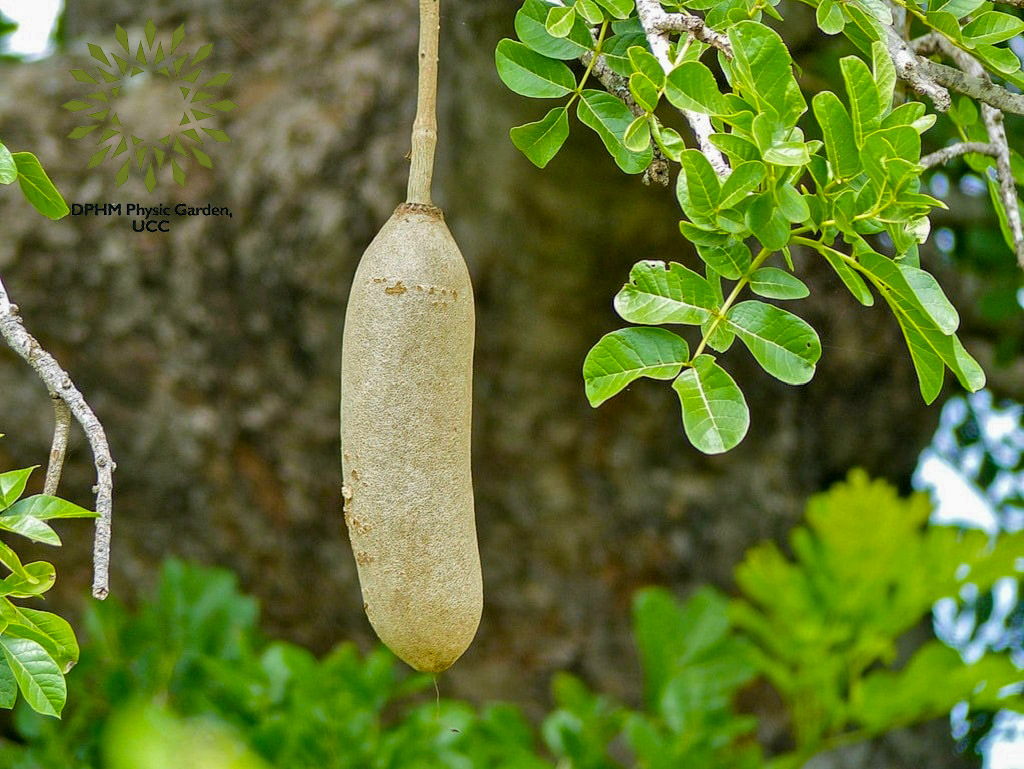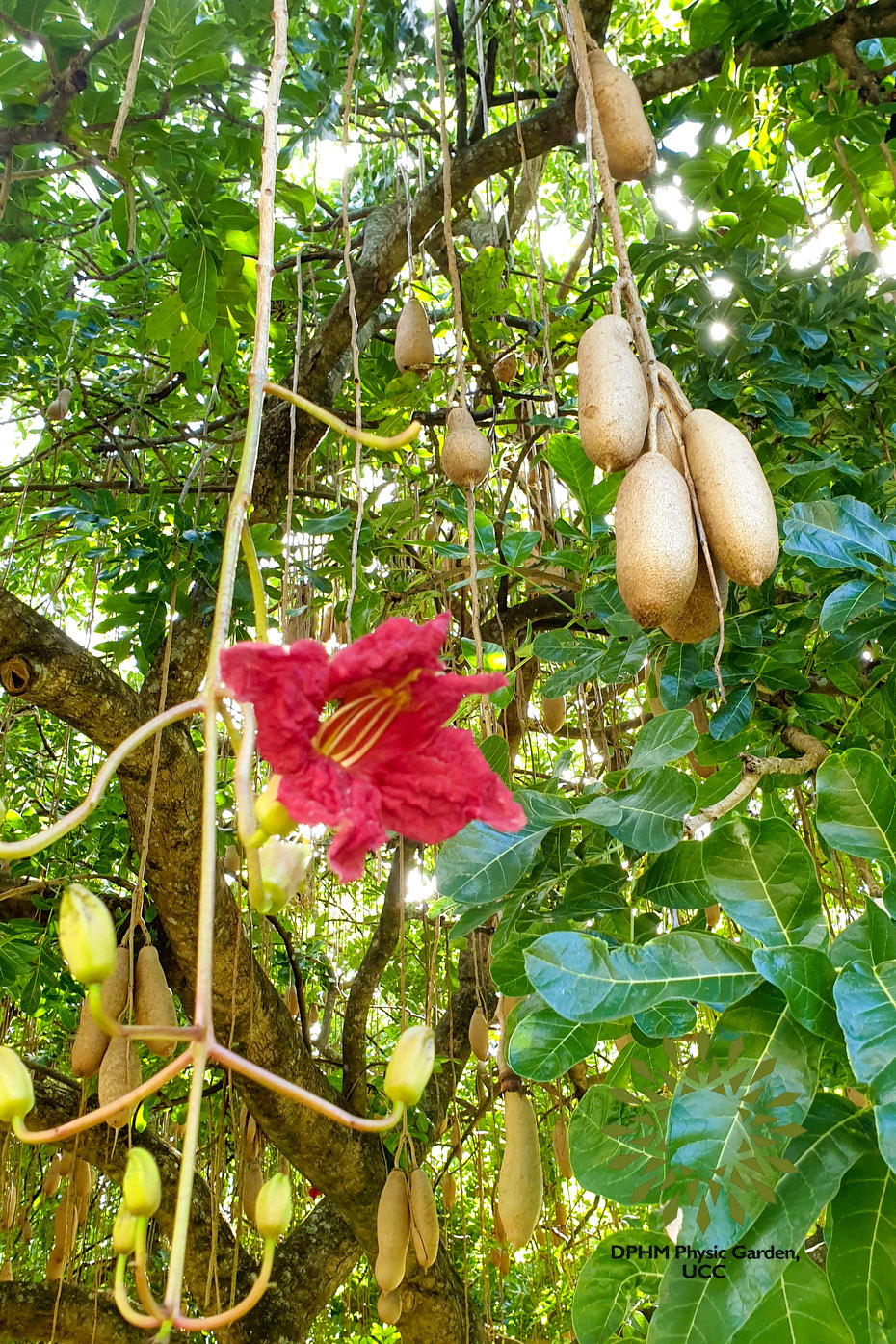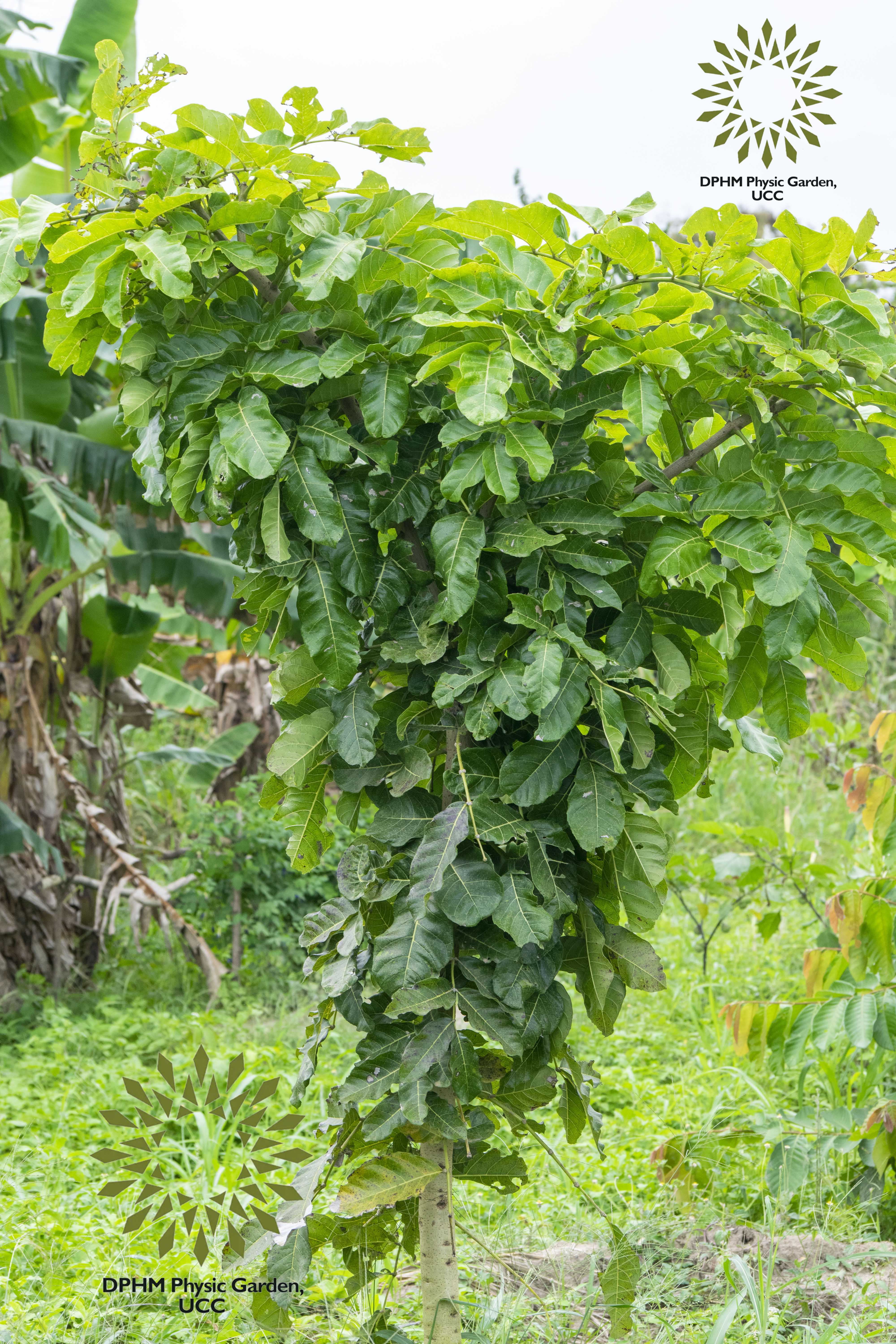CLASSIFICATION
Family: Bignoniaceae
Genus: Kigelia
Species: Kigelia africana
BOTANICAL DESCRIPTION
Kigelia africana, commonly known as the sausage tree, is a medium to large semi-deciduous tree that can grow up to 25 meters tall and has a dense, rounded crown. It features gray bark that peels off in older trees, revealing yellowish wood, which is not commercially valuable. The tree's leaves are opposite or whorled, pinnately compound, and can reach up to 60 cm in length. It produces large, maroon or dark red trumpet-shaped flowers that attract pollinators like fruit bats and butterflies due to their nectar. The tree bears sausage-shaped fruits that can grow up to 60 cm long and weigh between 5 to 10 kg, maturing from December to June.
PHYTOCHEMICALS
Kigelia africana contains several bioactive compounds, including flavonoids, phenolic acids such as alkaloids, saponins and tannins. Additionally, glycosides also exhibit anti-inflammatory and antimicrobial effects.
ETHNOMEDICINAL USES
Kigelia africana is a plant used for treating skin disorders, digestive issues, reproductive health, and respiratory disorders. Its roots, bark, leaves, and fruits alleviate diarrhea, stomachaches, and act as laxatives. Its leaves provide nutritional support and seeds can be consumed during famines. It also has antimicrobial and antiparasitic properties.
CHEMICAL STRUCTURE
PHARMACOLOGICAL ACTIVITY
ANTI-INFLAMMATORY AND ANALGESIC ACTIVITY
Extracts from different parts of K. africana have demonstrated potent anti-inflammatory and analgesic (pain-relieving) properties in various studies. These activities are likely due to the presence of iridoids, naphthoquinones, and other bioactive compounds.
ANTIOXIDANT ACTIVITY
K. africana exhibits strong antioxidant potential, which has been attributed to its high content of phenolic compounds, flavonoids, and other antioxidant phytochemicals. Different solvent extracts of the fruits have shown significant hydroxyl ion scavenging, metal ion chelating, and anti-lipid peroxidation activities.
ANTIMICROBIAL ACTIVITY
Extracts from K. africana have demonstrated antimicrobial effects against a range of pathogenic bacteria, fungi, and viruses. The antimicrobial activity is thought to be due to the presence of compounds like naphthoquinones and iridoids. In clinical microbiology, bacterial and fungal susceptibility tests are of paramount importance, as they help detect possible efficacy or resistance of common pathogens to the drug being tested.
ANTICANCER ACTIVITY
Several studies have reported the anticancer potential of K. africana extracts against various cancer cell lines. The antineoplastic effects are likely mediated by the presence of compounds like naphthoquinones and iridoids that can induce apoptosis and inhibit tumor growth.
ANTIDIABETIC ACTIVITY
Extracts of K. africana have shown promising antidiabetic effects in animal models, potentially due to their ability to modulate glucose metabolism and insulin sensitivity. The antioxidant and anti-inflammatory properties of the plant may also contribute to its antidiabetic potential.
DRUG-DRUG INTERACTION
The study explores the interaction between Kigelia africana compounds and antimalarial drugs like artemether and quinine, revealing potential synergistic effects against multidrug-resistant Plasmodium falciparum strains.
TOXICOLOGICAL PROFILE
Studies on Kigelia africana show different toxicity levels in its extracts. The aqueous bark extract caused significant behavioral and blood changes in juvenile Nile tilapia, with a 96-hour LC50 greater than 5 g/L, indicating potential ecological risks. The methanolic fruit extract was tolerated well in male Sprague-Dawley rats at doses up to 400 mg/kg, but higher doses (6400 mg/kg) led to toxicity symptoms and 60% mortality, with an estimated LD50 of 3981.07 mg/kg. In a chronic toxicity study, Wistar albino rats given aqueous fruit extract at 50 and 500 mg/kg showed no mortality or significant changes in blood parameters, while the control group had the highest weight gain.
CLINICALLY VALIDATED USES
It is primarily recognized for its effectiveness in treating skin disorders and promoting wound healing, with extracts commonly found in skin care products. The plant also exhibits significant antimalarial activity, as certain compounds enhance the effectiveness of existing antimalarial medications like artemether.
REFERENCES
Abbas, Z., Mustafa, S., Khan, M. F., Khan, M. A., Massey, S., Dev, K., Khan, A., Parveen, S., & Husain, S. A. (2023). Therapeutic importance of Kigelia africana subsp. africana: An alternative medicine. Natural Product Research, 1–15. https://doi.org/10.1080/14786419.2023.2273914
Assanti, G., Kaur, R., Nizard, S., Pollack, E., Rafferty, B., Priano, C., Fernández Romero, J. A., & Koroch, A. R. (2022). Biology, Chemistry, and Pharmacological Activity of Kigelia africana (Bignoniaceae) and Garcinia kola (Clusiaceae)—A Review. https://doi.org/10.7275/HECE-WP36
Azu, O. O., Duru, F. I. O., Osinubi, A. A., Oremosu, A. A., Noronha, C. C., Elesha, S. O., & Okanlawon, A. O. (2010). Histomorphometric effects of Kigelia africana (Bignoniaceae) fruit extract on the testis following short-term treatment with cisplatin in male Sprague–Dawley rats. Middle East Fertility Society Journal, 15(3), 200–208. https://doi.org/10.1016/j.mefs.2010.07.001
Bello, I., Shehu, M. W., Musa, M., Zaini Asmawi, Mohd., & Mahmud, R. (2016). Kigelia africana (Lam.) Benth. (Sausage tree): Phytochemistry and pharmacological review of a quintessential African traditional medicinal plant. Journal of Ethnopharmacology, 189, 253–276. https://doi.org/10.1016/j.jep.2016.05.049
Fagbohun, O. F., Babalola, O. O., Agboola, F. K., Joseph, J. S., Malindisa, S., & Msagati, T. A. M. (2020). Evaluation of Phytochemicals, Antioxidants, Trace Elements in Kigelia africana Fruit Extracts and Chemical Profiling Analysis Using UHPLC-qTOF-MS2 Spectrometry. Biological Trace Element Research, 195(2), 679–695. https://doi.org/10.1007/s12011-019-01869-2
Idowu, A. A., Popoola, O. C., Alani, J. O., Ipadeola, A., & Nwekoyo, V. E. (2020). Toxicity effect of Kigelia africana aqueous extract on the haematology and histopathology of juvenile Nile Tilapia (Oreochromis niloticus). Agro-Science, 19(1), 37. https://doi.org/10.4314/as.v19i1.6
Jorgensen, J. H., & Ferraro, M. J. (2009). Antimicrobial Susceptibility Testing: A Review of General Principles and Contemporary Practices. Clinical Infectious Diseases, 49(11), 1749–1755. https://doi.org/10.1086/647952
Jubilee, R., & Komala, M. (2022). Phytochemical and isolated compound speciocide from Kigelia africana fruit. International Journal of Health Sciences, 3944–3956. https://doi.org/10.53730/ijhs.v6nS8.13020
Mukavi, J. W., Mayeku, P. W., Nyaga, J. M., & Kituyi, S. N. (2020). In vitro anti-cancer efficacy and phyto-chemical screening of solvent extracts of Kigelia africana (Lam.) Benth. Heliyon, 6(7).
Nabatanzi, A., M. Nkadimeng, S., Lall, N., Kabasa, J. D., & J. McGaw, L. (2020). Ethnobotany, Phytochemistry and Pharmacological Activity of Kigelia africana (Lam.) Benth. (Bignoniaceae). Plants, 9(6), 753. https://doi.org/10.3390/plants9060753
Njogu, S. M., Arika, W. M., Machocho, A. K., Ngeranwa, J. J. N., & Njagi, E. N. M. (2018). In Vivo Hypoglycemic Effect of Kigelia africana (Lam): Studies With Alloxan-Induced Diabetic Mice. Journal of Evidence-Based Integrative Medicine, 23, 2515690X1876872. https://doi.org/10.1177/2515690X18768727
Olalye, M. T., & Rocha, J. B. T. (2007). Commonly used tropical medicinal plants exhibt distinct in vitro antioxidant activities against hepatotoxins in rat liver. Experimental and Toxicologic Pathology, 58(6), 433–438. https://doi.org/10.1016/j.etp.2007.01.002
Ramadan, K. M. A., El-Beltagi, H. S., Mohamed, H. I., Shalaby, T. A., Galal, A., Mansour, A. T., Aboul Fotouh, M. M., & Bendary, E. S. A. (2022). Antioxidant, Anti-Cancer Activity and Phytochemicals Profiling of Kigelia pinnata Fruits. Separations, 9(11), 379. https://doi.org/10.3390/separations9110379
Shama, S., Adam, I. Y., Marwa, M., & Alhameed, I. A. (2013). Kigelia Africana Fruits’ Extracts anti Hepato-Toxic Effects on Male Wistar Rats Liver Destruction Induced by CCL4. Asian Journal of Medical Sciences, 5(1), 26–32. https://doi.org/10.19026/ajms.5.5342
Singh, L., Joshi, T., Tewari, D., Echeverría, J., Mocan, A., Sah, A. N., Parvanov, E., Tzvetkov, N. T., Ma, Z. F., Lee, Y. Y., Poznański, P., Huminiecki, L., Sacharczuk, M., Jóźwik, A., Horbańczuk, J. O., Feder-Kubis, J., & Atanasov, A. G. (2020). Ethnopharmacological Applications Targeting Alcohol Abuse: Overview and Outlook. Frontiers in Pharmacology, 10, 1593. https://doi.org/10.3389/fphar.2019.01593
Van Wyk, B.-E., & Van Staden, J. (2002). A review of ethnobotanical research in southern Africa. South African Journal of Botany, 68(1), 1–13. https://doi.org/10.1016/S0254-6299(16)30447-1
Zofou, D., Kengne, A. B. O., Tene, M., Ngemenya, M. N., Tane, P., & Titanji, V. P. K. (2011). In vitro antiplasmodial activity and cytotoxicity of crude extracts and compounds from the stem bark of Kigelia africana (Lam.) Benth (Bignoniaceae). Parasitology Research, 108(6), 1383–1390. https://doi.org/10.1007/s00436-011-2363-y




INFORMATION, DATA AND PICTURES ARE COPYRIGHT OF DPHM, SCHOOL OF PHARMACY, UCC.

